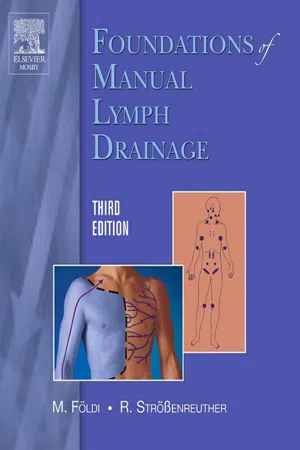
- 120 pages
- English
- ePUB (mobile friendly)
- Available on iOS & Android
Foundations of Manual Lymph Drainage
About this book
This manual lymph drainage guide covers the anatomy, physiology, and pathophysiology of the lymphatic system, providing key background information necessary for effective treatment. Chapters are structured according to anatomic regions, focusing on the lymphatic knots and their tributary regions in the throat, armpit, trunk, and groin. Photographs illustrate the lymphatic knots and lymphatic courses, which are drawn on the human body, and provide a clear picture of the structures to be treated. Designated points are numbered to illustrate the progression of treatment in each region. Also includes coverage of complete decongestive therapy (CDT).- Explains procedures in a detailed, step-by-step format.- Features a helpful chart of lymph node groups and their tributary regions that outlines each lymph node as it pertains to a specific anatomical region.- Key information is summarized in the margins, making it easier for readers to review what they've read and focus on important topics.- Self-test questions provide an excellent means for readers to assess their comprehension and review key material in the book. These questions are also helpful in preparing for exams.- Two-color illustrations help the reader visualize and learn theoretical aspects of this therapy.- The text has been completely updated to reflect the latest techniques in lymph drainage therapy.- Coverage of individual treatment strokes and stroke sequences have been updated, with more comprehensive descriptions and detailed photos that illustrate proper hand placement, pressure, and movement.- Expanded coverage of complete decongestive therapy, including a CDT survey — consisting of the case history, examination, and palpation — that can be used to gather valuable information to formulate therapeutic goals and evaluate treatment results.
Frequently asked questions
- Essential is ideal for learners and professionals who enjoy exploring a wide range of subjects. Access the Essential Library with 800,000+ trusted titles and best-sellers across business, personal growth, and the humanities. Includes unlimited reading time and Standard Read Aloud voice.
- Complete: Perfect for advanced learners and researchers needing full, unrestricted access. Unlock 1.4M+ books across hundreds of subjects, including academic and specialized titles. The Complete Plan also includes advanced features like Premium Read Aloud and Research Assistant.
Please note we cannot support devices running on iOS 13 and Android 7 or earlier. Learn more about using the app.
Information
1.1 LYMPH VESSEL SYSTEM










Table of contents
- Cover
- Title Page
- Copyright
- About the Authors
- Preface
- Abbreviations
- Illustration Credits
- Table of Contents
- Chapter 1: Anatomy of the Lymph Vessel System
- Chapter 2: Interstitial Fluid and Lymph
- Chapter 3: Lymph Formation and Lymph Flow: “Physiological Lymph Drainage”
- Chapter 4: Lymphatic System Insufficiency
- Chapter 5: Effect of Massage on Lymph Formation and Lymphangiomotor Function
- Chapter 6: Basic Principles of Manual Lymph Drainage
- Chapter 7: Treatment of the Cervical Lymph Nodes and Their Tributary Regions
- Chapter 8: Treatment of the Axillary Lymph Nodes and Their Tributary Territories
- Chapter 9: Treatment of the Large, Deep Lymphatic Trunks
- Chapter 10: Treatment of the Inguinal Lymph Nodes and Their Tributary Regions
- Chapter 11: Complete Decongestive Therapy
- Index